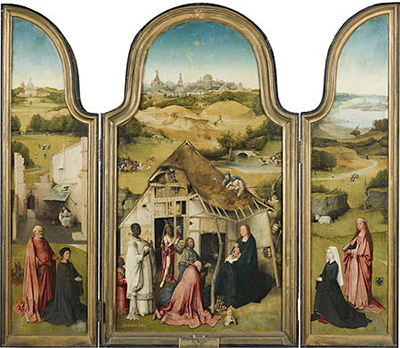Adoration of the Magi by Hieronymus Bosch depicts a classic scene from the Christian tradition: the Three Wise Men (or Magi) greeting and worshipping the infant Jesus.
Many other famous artists have tackled this theme, with Leonardo da Vinci being a particularly well known example. Bosch brings his own style to this topic with Adoration of the Magi, though: a style which is intricate, quirky and very individualistic.
Created between 1485 and 1500 (as with many of Bosch's works, the exact date of the painting's execution is unknown), Adoration of the Magi is a triptych.
A triptych is an art work that is made up of three paintings on three panels. Very often (and this is indeed the case with Adoration of the Magi), the three paintings are joined together by hinges and so the triptych folds out to reveal the full glory of the work. Another triptych by Bosch is The Temptation of Saint Anthony, for instance.
Bosch's quirky way of viewing the world is definitely in evidence in Adoration of the Magi, though it is somewhat more muted than in other works by him such as The Garden of Earthly Delights.
Look, for example, at the wobbly shape of the house in Adoration of the Magi and at the dynamic scenes that can be seen in the background (such as the monstrous beast devouring or attacking a human figure in the right hand panel). These small dramas and odd perspectives are typical of Bosch's work.
Another interesting aspect of Adoration of the Magi is the way that the triptych looks when the right and left hand panels are folded inwards and the triptych is 'closed'. Painted on the reverse sides of the panels, the viewer can see an altar with priests and other worshippers adoring a statue of the adult Christ.
The connection to be made here is clear: the magi's adoration of the infant Christ is, in Bosch's late medieval and early Renaissance world, something that is replicated in the acts of worship that are performed in church on a daily basis by Christians in church.




